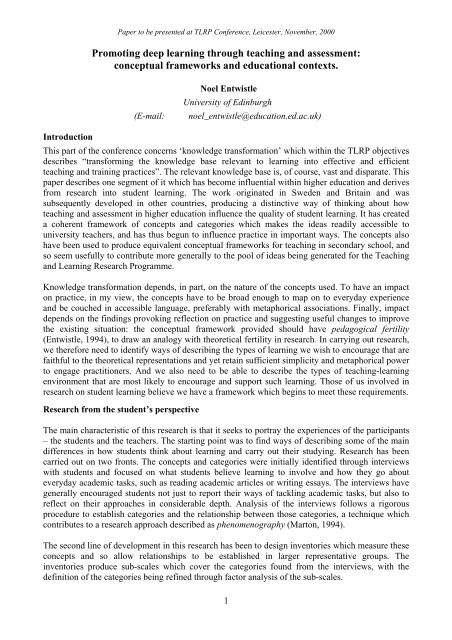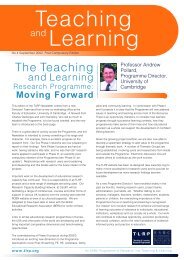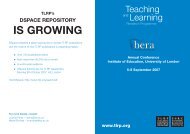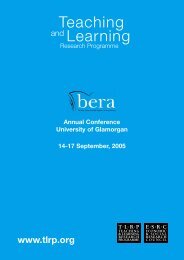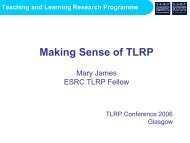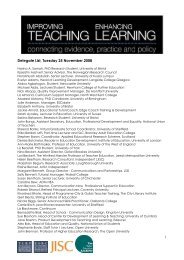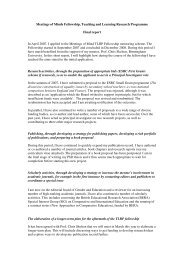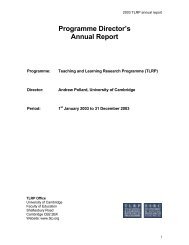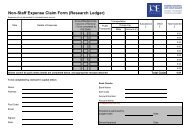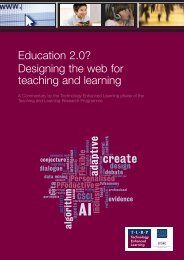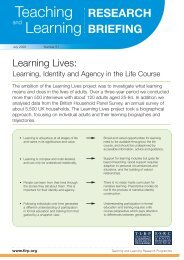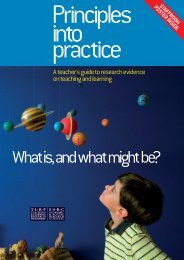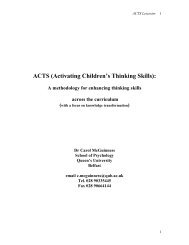Promoting deep learning through teaching and assessment
Promoting deep learning through teaching and assessment
Promoting deep learning through teaching and assessment
Create successful ePaper yourself
Turn your PDF publications into a flip-book with our unique Google optimized e-Paper software.
Paper to be presented at TLRP Conference, Leicester, November, 2000<strong>Promoting</strong> <strong>deep</strong> <strong>learning</strong> <strong>through</strong> <strong>teaching</strong> <strong>and</strong> <strong>assessment</strong>:conceptual frameworks <strong>and</strong> educational contexts.(E-mail:Noel EntwistleUniversity of Edinburghnoel_entwistle@education.ed.ac.uk)IntroductionThis part of the conference concerns ‘knowledge transformation’ which within the TLRP objectivesdescribes “transforming the knowledge base relevant to <strong>learning</strong> into effective <strong>and</strong> efficient<strong>teaching</strong> <strong>and</strong> training practices”. The relevant knowledge base is, of course, vast <strong>and</strong> disparate. Thispaper describes one segment of it which has become influential within higher education <strong>and</strong> derivesfrom research into student <strong>learning</strong>. The work originated in Sweden <strong>and</strong> Britain <strong>and</strong> wassubsequently developed in other countries, producing a distinctive way of thinking about how<strong>teaching</strong> <strong>and</strong> <strong>assessment</strong> in higher education influence the quality of student <strong>learning</strong>. It has createda coherent framework of concepts <strong>and</strong> categories which makes the ideas readily accessible touniversity teachers, <strong>and</strong> has thus begun to influence practice in important ways. The concepts alsohave been used to produce equivalent conceptual frameworks for <strong>teaching</strong> in secondary school, <strong>and</strong>so seem usefully to contribute more generally to the pool of ideas being generated for the Teaching<strong>and</strong> Learning Research Programme.Knowledge transformation depends, in part, on the nature of the concepts used. To have an impacton practice, in my view, the concepts have to be broad enough to map on to everyday experience<strong>and</strong> be couched in accessible language, preferably with metaphorical associations. Finally, impactdepends on the findings provoking reflection on practice <strong>and</strong> suggesting useful changes to improvethe existing situation: the conceptual framework provided should have pedagogical fertility(Entwistle, 1994), to draw an analogy with theoretical fertility in research. In carrying out research,we therefore need to identify ways of describing the types of <strong>learning</strong> we wish to encourage that arefaithful to the theoretical representations <strong>and</strong> yet retain sufficient simplicity <strong>and</strong> metaphorical powerto engage practitioners. And we also need to be able to describe the types of <strong>teaching</strong>-<strong>learning</strong>environment that are most likely to encourage <strong>and</strong> support such <strong>learning</strong>. Those of us involved inresearch on student <strong>learning</strong> believe we have a framework which begins to meet these requirements.Research from the student’s perspectiveThe main characteristic of this research is that it seeks to portray the experiences of the participants– the students <strong>and</strong> the teachers. The starting point was to find ways of describing some of the maindifferences in how students think about <strong>learning</strong> <strong>and</strong> carry out their studying. Research has beencarried out on two fronts. The concepts <strong>and</strong> categories were initially identified <strong>through</strong> interviewswith students <strong>and</strong> focused on what students believe <strong>learning</strong> to involve <strong>and</strong> how they go abouteveryday academic tasks, such as reading academic articles or writing essays. The interviews havegenerally encouraged students not just to report their ways of tackling academic tasks, but also toreflect on their approaches in considerable depth. Analysis of the interviews follows a rigorousprocedure to establish categories <strong>and</strong> the relationship between those categories, a technique whichcontributes to a research approach described as phenomenography (Marton, 1994).The second line of development in this research has been to design inventories which measure theseconcepts <strong>and</strong> so allow relationships to be established in larger representative groups. Theinventories produce sub-scales which cover the categories found from the interviews, with thedefinition of the categories being refined <strong>through</strong> factor analysis of the sub-scales.1
These complementary strategies have not just established relationships between inventory subscales,they have also indicated how <strong>teaching</strong> <strong>and</strong> <strong>assessment</strong>, <strong>and</strong> other aspects of the <strong>teaching</strong><strong>learning</strong>environment, influence students’ ways of studying <strong>and</strong> the levels of underst<strong>and</strong>ing reached.This paper begins with a brief summary of the main concepts which form the coherent framework.Other research will be used to show the influences on <strong>learning</strong> of the interaction between students<strong>and</strong> the <strong>teaching</strong>-<strong>learning</strong> environment. In this way, the process of knowledge transformation willbe explored <strong>and</strong> used to suggest relevance beyond higher education.Conceptions of <strong>learning</strong> <strong>and</strong> approaches to studyingUsing interview methodology, the broadest of the concepts in research on student <strong>learning</strong> camefrom the responses of adults who were asked “What do you mean by ‘<strong>learning</strong>’?”. As in all thisresearch, the variation in people’s responses provided the research findings. They had very differentconceptions of <strong>learning</strong> (Säljö, 1979; Marton & Säljö, 1997), which involved a hierarchy which hasparallels with the developmental trend in students’ thinking – their epistemological levels -identified earlier by Perry (1970) (see Figure 1). Perry found that students initially saw <strong>learning</strong>mainly as a matter of memorising <strong>and</strong> reproducing knowledge in ways acceptable to the teacher.During their time at university, students gradually began to recognise that <strong>learning</strong> was morerewarding when they sought personal meaning by transforming information <strong>and</strong> ideas in terms oftheir own previous knowledge <strong>and</strong> underst<strong>and</strong>ing.Figure 1Conceptions of <strong>learning</strong> <strong>and</strong> epistemological levelsDualismEpistemological levelRelativismKnowledgeseenas absoluteMultipleperspectives,own opinionKnowledgeseen asprovisionalEvidence usedto reason withCommitmentto a reasonedinterpretationExp<strong>and</strong>ing awareness <strong>through</strong> a nested hierarchy of conceptionsReproducingConceptions of <strong>learning</strong>TransformingAcquiringinformationBuilding upknowledgeroutinelyApplyingknowledge<strong>and</strong> skillsMaking senseof ideas <strong>and</strong>the real worldDevelopingas a person2
Paper to be presented at TLRP Conference, Leicester, November, 2000The epistemological level or conception of <strong>learning</strong> students have reached substantially affects theways in which they tackle everyday academic tasks, which have been described in terms ofapproaches to <strong>learning</strong> <strong>and</strong> studying. The starting point of this research was an investigation intohow students went about reading (Marton & Säljö, 1976; Marton, Hounsell & Entwistle, 1997).Students were asked, individually, to read an academic article <strong>and</strong> were told that they would beasked questions on it afterwards. It became clear from the transcripts that students had interpretedthis instruction very differently, <strong>and</strong> their ability to answer questions about the meaning of the textdepended on how they had decided to tackle the task. Some students had sought a thoroughunderst<strong>and</strong>ing of the author’s message, while others had relied on ‘question-spotting’ - <strong>learning</strong> justthose pieces of information expected to come up in the test. This distinction was gradually refined<strong>through</strong> qualitative analysis to produce a descriptive concept with two categories - <strong>deep</strong> <strong>and</strong> surfaceapproaches to <strong>learning</strong> – in which a specific intention brings into play <strong>learning</strong> process which leadto qualitatively different <strong>learning</strong> outcomes.In the <strong>deep</strong> approach, the intention to extract meaning produces active <strong>learning</strong> processes thatinvolve relating ideas <strong>and</strong> looking for patterns <strong>and</strong> principles on the one h<strong>and</strong> (a holist strategy -Pask, 1976, 1988), <strong>and</strong> using evidence <strong>and</strong> examining the logic of the argument on the other(serialist). The approach also involves monitoring the development of one’s own underst<strong>and</strong>ing(Entwistle, McCune & Walker, 2000). In the surface approach, in contrast, the intention is just tocope with the task, which sees the course as unrelated bits of information which leads to much morerestricted <strong>learning</strong> processes, in particular to routine memorisation.Interviews on everyday studying drew attention to the pervasive influence of <strong>assessment</strong> procedureson <strong>learning</strong> <strong>and</strong> studying. They suggested the need for an additional category - strategic approach -in which the intention is to achieve the highest possible grades by using organised study methods<strong>and</strong> good time-management (Entwistle & Ramsden, 1983). This approach also involves monitoringone’s study effectiveness (Entwistle, McCune & Walker, 2000) <strong>and</strong> an alertness to the <strong>assessment</strong>process, aspects which are akin to metacognitive alertness <strong>and</strong> self-regulation (Vermunt, 1998;Pintrich & Garcia, 1994). Interviews with students suggest that strategic students have two distinctfocuses of concern - the academic content <strong>and</strong> the dem<strong>and</strong>s of the <strong>assessment</strong> system. The interest inthe content is typical of a <strong>deep</strong> approach, but the alertness to <strong>assessment</strong> requirements is typicallystrategic (Entwistle, 2000). Whereas the distinction between <strong>deep</strong> <strong>and</strong> surface approaches wasderived from analyses which focused on extracting meaning from text, the strategic approach,together with its opposite - the apathetic approach (Tait & Entwistle, 1996) - indicate how studentsact in everyday study situations. They are therefore better described as approaches to studying.The research on student <strong>learning</strong> began with interviews, but soon led to the construction ofinventories to assess the predominant approach being used. One such inventory was the Approachesto Studying Inventory (Entwistle & Ramsden, 1983) which has led recently to ASSIST (Approaches<strong>and</strong> Study Skills Inventory for Students – Tait, Entwistle & McCune, 1998). The way in which thevarious sub-scales of this most recent inventory come together to define the characteristics of thesuccessful student is illustrated in Figure 2. The links shown there also indicates that the <strong>deep</strong>,strategic approach, without any elements of surface apathetic, is generally associated with successfulacademic performance (Entwistle, 2000).3
Figure 2Components of the ASSIST inventory contributing to effective studyingDeep, strategic approaches to studying,without surface, apathetic elementsNegativeDeep, strategicSurface, apatheticHolistSerialistNegativeDeep Strategic SurfaceRelatingideasUsingevidenceTimemanagementOrganisedstudyingFear offailureRoutinememorisingInterest in ideas <strong>and</strong>monitoring underst<strong>and</strong>ingAlertness to <strong>assessment</strong> <strong>and</strong>monitoring studyingSyllabus-bound focus onminimum requirementsIntention to seek meaningfor yourselfIntention to achieve thehighest possible gradesIntention to cope minimallywith course requirementsThe idea of approaches to <strong>learning</strong> <strong>and</strong> studying has had a powerful influence on both theory <strong>and</strong>practice related to <strong>teaching</strong> <strong>and</strong> <strong>learning</strong> in higher education, at least in Britain <strong>and</strong> Australia. The<strong>deep</strong>-surface distinction has metaphorical strength <strong>and</strong> is broadly applicable, while the term‘strategic’ is also readily understood. There are important caveats, however, in using thesecategories. First, they are analytic categories derived from the research findings that can only beused to describe the relative prominence of each approach to studying in any student. It is wrong totry to put any student wholly into any one category. Then, the definition of the <strong>deep</strong> approach isgeneric, while the processes needed to develop <strong>deep</strong> <strong>learning</strong> necessarily vary between subject areas.Further, the categories are broad, indicative labels which do not do justice to the complexity ofindividual ways of studying (McCune, 1998; McCune & Entwistle, 2000). And finally, an approach,strictly speaking, can only be applied with any confidence to a particular <strong>teaching</strong>-<strong>learning</strong>environment, as the approach is the result of an interaction between the student <strong>and</strong> that context, aswe shall see.Outcomes of <strong>learning</strong>A <strong>deep</strong> strategic approach to studying is generally related to high levels of academic achievement,but only where the <strong>assessment</strong> procedures emphasise <strong>and</strong> reward personal underst<strong>and</strong>ing. Otherwise,surface strategic approaches may well prove more adaptive. Even where the <strong>assessment</strong> does stressunderst<strong>and</strong>ing, the levels students reach will still, of course, vary. The idea of qualitatively differentoutcomes of <strong>learning</strong> was another product of the work of Marton <strong>and</strong> his colleagues (Marton &Säljö, 1976, 1997), <strong>and</strong> was operationalised independently by Biggs <strong>and</strong> Collis (1983) <strong>through</strong> theirSOLO taxonomy. In a series of interview studies in Edinburgh, we have been exploring the forms ofunderst<strong>and</strong>ing experienced by final year: five distinct categories were identified which varied interms of their breadth, depth <strong>and</strong> structure (Entwistle, 1995, 1998a; Entwistle & Entwistle, 1997).4
Paper to be presented at TLRP Conference, Leicester, November, 2000Building on the earlier research, we were able to suggest how to describe, in general terms, thequalitative differences in outcomes of <strong>learning</strong> found in the ways students tackle their written work.These are outlined in Table 1.Table 1Levels of underst<strong>and</strong>ing as outcomes of <strong>learning</strong>MentioningDescribingRelatingExplainingConceivingIncoherent bits of information without any obvious structureBrief descriptions of topics derived mainly from material providedOutline, personal explanations lacking detail or supporting argumentRelevant evidence used to develop structured, independent argumentsIndividual conceptions of topics developed <strong>through</strong> reflectionThese attempts at describing outcomes of <strong>learning</strong> have been generic <strong>and</strong> can only be used to guidethe description of outcomes within a course or subject area. More recent work by Marton <strong>and</strong> his coworkerssuggests how it is possible to identify the differing conceptions that students hold of specifictopics within a course or discipline (Bowden & Marton, 1998), which can then be used to define thequality of <strong>learning</strong> outcomes <strong>and</strong> grades. The task of investigating conceptions for every topic ineach course is clearly impracticable, but encouraging academic staff to think in this way about howto assess assignments <strong>and</strong> examination answers is one way of ensuring that personal underst<strong>and</strong>ingis given due weight within the <strong>assessment</strong> procedures.Conceptions of <strong>teaching</strong>Previously, we introduced the notion of a hierarchy of conceptions of <strong>learning</strong>: more recent researchhas suggested a similar hierarchy describing conceptions of <strong>teaching</strong>. In interviews, faculty membershave been asked to describe what they mean by ‘<strong>learning</strong>’ <strong>and</strong> ‘<strong>teaching</strong>’, <strong>and</strong> to indicate theirbeliefs about <strong>teaching</strong> <strong>and</strong> <strong>assessment</strong> (Prosser, Trigwell & Taylor, 1994; Van Driel et al., 1997;Kember, 1998). From such studies, three main categories typically emerge, ones which closelyparallel in their underlying meaning those found by both Säljö <strong>and</strong> Perry. Some colleagues talkabout the importance of covering the syllabus <strong>and</strong> ensuring that students acquire the correctinformation <strong>and</strong> ideas: they have a conception which has been described as teacher-focused, <strong>and</strong>content-oriented. Another group was described as focusing on student activity, with an emphasis onproviding assignments designed to ensure active <strong>learning</strong> <strong>and</strong> helping students to develop effectivestudy skills. Yet this group still saw <strong>learning</strong> only from their own perspective. The final group,smaller than the other two, was labelled student-focused, <strong>and</strong> <strong>learning</strong>-oriented. Staff in this groupwere more concerned with helping students to develop personal underst<strong>and</strong>ing <strong>and</strong> moresophisticated conceptions, <strong>and</strong> designed their <strong>teaching</strong> <strong>and</strong> <strong>assessment</strong> accordingly.Teachers with these contrasting conceptions of <strong>teaching</strong>, tend to hold corresponding views on<strong>assessment</strong> procedures <strong>and</strong> on the ability <strong>and</strong> motivation of their students (Van Driel et al., 1997).Staff who are content-oriented are likely to see <strong>assessment</strong> as designed to demonstrate detailedfactual knowledge of the syllabus. They also tend to consider the outcomes of <strong>learning</strong> as beingalmost entirely the responsibility of the students themselves, depending on their ability <strong>and</strong>motivation. The student-focused group tend to use more varied methods of <strong>assessment</strong> <strong>and</strong> to beaware of their own responsibility for encouraging students to develop <strong>deep</strong> levels of underst<strong>and</strong>ing.The conceptions of both <strong>learning</strong> <strong>and</strong> <strong>teaching</strong> held by teachers also affect their approaches to<strong>teaching</strong> (Trigwell & Prosser, 1999).5
Paper to be presented at TLRP Conference, Leicester, November, 2000It provides a much broader concept map in which <strong>teaching</strong>, <strong>assessment</strong> procedures, <strong>and</strong> other aspectsof the <strong>teaching</strong>-<strong>learning</strong> environment are all shown as influencing the outcome of <strong>learning</strong>. Againthis diagram derives from research findings, but the links have only been partially established so far;gaps have been filled by drawing on professional experience.Figure 4A conceptual overview of the <strong>teaching</strong>-<strong>learning</strong> processStudent CharacteristicsPERSONALITYATTITUDESTO COURSELEARNINGSTYLEMOTIVATIONPRIORKNOWLEDGELEVELPACEINTELLECTUALABILITIESPERCEPTIONS OF MEANING & RELEVANCESTRUCTURECLARITYEXPLANATIONAPPROACHTOLEARNINGAPPROACHTOTEACHINGENTHUSIASMLEARNINGSTRATEGIESLEARNINGOUTCOMESSELECTIONOFCONTENTAPPROACHTOSTUDYINGWORK HABITSPERCEPTIONS OF TASK REQUIREMENTSPOLICYONTEACHINGASSESSMENTPROCEDURESFREEDOM OFCHOICEWORKLOADLEARNINGMATERIALSSTUDY SKILLSSTUDY SKILLSSUPPORTLIBRARYPROVISIONLECTURESEMPATHYFEEDBACKTO STUDENTSCOURSE DESIGN AND OBJECTIVESDISCUSSION GROUPSPRACTICALSDEPARTMENTAL TEACHING ETHOSTeaching CharacteristicsDepartmental CharacteristEssentially, Figure 4 seeks to draw attention to the interaction between the characteristics of thestudents in the top half of the diagram <strong>and</strong> those of the teacher <strong>and</strong> the department in the bottomhalf. Student characteristics are divided into those which describe cognitive aspects <strong>and</strong> ways ofthinking on the left, <strong>and</strong> those which are mainly affective or related to study practices on the right.The influence of <strong>teaching</strong> is indicated in the bottom right quadrant, but the approach to <strong>teaching</strong> isshown in detail only in relation to lecturing, where most research evidence currently exists. Thebottom right indicates aspects of the <strong>teaching</strong>-<strong>learning</strong> environment over which individual lecturershave much less control, such as <strong>assessment</strong> procedures <strong>and</strong> the choice offered to students.An important feature of the diagram is the division between the upper <strong>and</strong> lower halves, where theperceptions of meaning <strong>and</strong> relevance <strong>and</strong> of task requirements are shown. Research has shown that,while <strong>teaching</strong>-<strong>learning</strong> environments affect approaches to <strong>learning</strong> <strong>and</strong> studying, they do not do soin a uniform way. The effects are mediated by the ways in which the individual student perceivesaspects of the provision (Entwistle & Ramsden, 1983).7
Figure 1Concept map of influences on underst<strong>and</strong>ing in the classroomHistorical influences on student's underst<strong>and</strong>ingSupport <strong>and</strong> encouragement from family <strong>and</strong> friendsAttitudes towards education of peers <strong>and</strong> social groupMotivation <strong>and</strong>level of interestApproach to studying <strong>and</strong>beliefs about <strong>learning</strong>Level <strong>and</strong> mixof abilitiesStudent's current knowledge<strong>and</strong> underst<strong>and</strong>ingDevelopmental trendPerception of the<strong>learning</strong> contextComprehension oftopics <strong>and</strong> targetStudent's ownproximal influence onpersonal underst<strong>and</strong>ingStrategy, effort<strong>and</strong> engagementStudent's personalunderst<strong>and</strong>ing of topicAssessed <strong>learning</strong> outcomes<strong>and</strong> levels of underst<strong>and</strong>ingMatch betweenpersonal <strong>and</strong> targetunderst<strong>and</strong>ingsTeacher'sproximal influence onpersonal underst<strong>and</strong>ingPresentation <strong>and</strong> explanation oftopics <strong>and</strong> target underst<strong>and</strong>ingTeacher's targetunderst<strong>and</strong>ing for topicInterpretation of target underst<strong>and</strong>ing<strong>and</strong> choice of topics <strong>and</strong> <strong>assessment</strong>Proximal influences onteacher's underst<strong>and</strong>ingTarget underst<strong>and</strong>ingpresented in the syllabusConception ofthe subjectTeaching style<strong>and</strong> approachRelationshipwith the classTeacher's conception of <strong>teaching</strong><strong>and</strong> beliefs about <strong>learning</strong>Developmental trendHistorical influences on student's underst<strong>and</strong>ing10
Paper to be presented at TLRP Conference, Leicester, November, 2000ReferencesBiggs, J. B. (1999). Teaching for Quality Learning at University. Buckingham: Open UniversityPress.Biggs, J. B. & Collis, K. F. (1982).Evaluating the quality of <strong>learning</strong>: the SOLO taxonomy. NewYork: Academic Press.Blythe, T. <strong>and</strong> associates (1998). The Teaching for Underst<strong>and</strong>ing Guide. San Francisco: Jossey-Bass.Bowden, J. & Marton, F. (1998). The University of Learning. London: Kogan Page.Entwistle, N. J. (1994). Generative concepts <strong>and</strong> pedagogical fertility: Communicating researchfindings on student <strong>learning</strong>. Presidential address to the European Association for Research onLearning <strong>and</strong> Instruction. EARLI News, June, 1994, 9-15.Entwistle, N. J. (1995). Frameworks for underst<strong>and</strong>ing as experienced in essay writing <strong>and</strong> inpreparing for examinations. Educational Psychologist, 30, 47-54.Entwistle, N. J. (1998a). Approaches to <strong>learning</strong> <strong>and</strong> forms of underst<strong>and</strong>ing. In B. Dart <strong>and</strong> G.Boulton-Lewis (Eds.), Teaching <strong>and</strong> Learning in Higher Education (pp. 72-101). Melbourne:Australian Council for Educational Research.Entwistle, N. J. (1998b). Improving <strong>teaching</strong> <strong>through</strong> research on student <strong>learning</strong>. In J. J. F. Forest(Ed.), University Teaching: International Perspectives (pp. 73-112). New York: Garl<strong>and</strong>.Entwistle N. J. (2000). Approaches to studying <strong>and</strong> levels of underst<strong>and</strong>ing: the influences of<strong>teaching</strong> <strong>and</strong> <strong>assessment</strong>. In J. C. Smart (Ed.), Higher Education: H<strong>and</strong>book of Theory <strong>and</strong>Research (Vol. XV) (pp. 156-218). New York: Agathon Press.Entwistle, N. J., & Entwistle, A. C. (1997). Revision <strong>and</strong> the experience of underst<strong>and</strong>ing. In F.Marton, D. J., Hounsell, & N. J. Entwistle (Eds.), The Experience of Learning (2nd ed.) (pp.145-158). Edinburgh: Scottish Academic Press.Entwistle, N. J., McCune, V. & Walker, P. (2000). Conceptions, styles <strong>and</strong> approaches withinhigher education: analytic abstractions <strong>and</strong> everyday experience. In R. J. Sternberg & L-F.Zhang (Eds.), Perspectives on Cognitive, Learning, <strong>and</strong> Thinking Styles. Mahwah, N. J.:Lawrence Erlbaum (in press).Entwistle, N.J., & Ramsden, P. (1983). Underst<strong>and</strong>ing Student Learning. London: Croom Helm.Entwistle, N. J. & Smith, C. A. (2000). Target underst<strong>and</strong>ing <strong>and</strong> personal underst<strong>and</strong>ing: a questionof match (under review).Entwistle, N. J. & Tait, H. (1996). Identifying students at risk <strong>through</strong> ineffective study strategies.Higher Education, 31, 97-116.Kember, D. (1998). Teaching beliefs <strong>and</strong> their impact on students’ approach to <strong>learning</strong>. In B. Dart& G. Boulton-Lewis (Eds.), Teaching <strong>and</strong> Learning in Higher Education (pp. 1-25).Melbourne: Australian Council for Educational Research.Marton, F. (1994). Phenomenography. In T. Husen, <strong>and</strong> N. Postlethwaite (Eds.), InternationalEncyclopedia of Education (pp. 4424 - 4429). Oxford: Pergamon.Marton, F. & Booth, S. (1997). Learning <strong>and</strong> Awareness. Mahwah, N. J.: Lawrence Erlbaum.Marton, F., & Säljö, R. (1976). On qualitative differences in <strong>learning</strong>. I. Outcome <strong>and</strong> process.British Journal of Educational Psychology, 46, 4-11.Marton, F., & Säljö, R. (1997). Approaches to <strong>learning</strong>. In F. Marton, D. J. Hounsell, & N. J.Entwistle (Eds.), The Experience of Learning (2nd ed.). Edinburgh: Scottish Academic Press.McCune, V. (1998). Academic development during the first year at university. In C. Rust (Ed.),Improving Students as Learners (pp. 354-358). Oxford: Oxford Brookes University, Centre forStaff <strong>and</strong> Learning Development.11
McCune, V.& Entwistle, N. J. (2000). The <strong>deep</strong> approach to <strong>learning</strong>: analytic abstraction <strong>and</strong>idiosyncratic development. Paper presented at the Innovations in Higher Education Conference,Helsinki, August 30- September 2, 2000.Pask, G. (1976). Styles <strong>and</strong> strategies of <strong>learning</strong>. British Journal of Educational Psychology, 46,128-148.Pask, G. (1988). Learning strategies, <strong>teaching</strong> strategies <strong>and</strong> conceptual or <strong>learning</strong> style. In R.R.R.R. Schmeck (Ed.), Learning strategies <strong>and</strong> <strong>learning</strong> styles. New York: Plenum Press.Perry, W.G. (1970). Forms of Intellectual <strong>and</strong> Ethical Development in the College Years: AScheme. New York: Holt, Rinehart & Winston.Pintrich, P. R. & Garcia, T. (1994). Self-regulated <strong>learning</strong> in college students: knowledge,strategies <strong>and</strong> motivation. In P. R. Pintrich, D. R. Brown & C-E Weinstein (Eds.), StudentMotivation Cognition <strong>and</strong> Learning. (pp. 113-134). Hillsdale, N.J.: Lawrence Erlbaum.Prosser, M., Trigwell, K., & Taylor, P. (1994). A phenomenographic study of academics’conceptions of science <strong>learning</strong> <strong>and</strong> <strong>teaching</strong>. Learning & Instruction, 4, 217-232.Säljö, R. (1979). Learning in the Learner’s Perspective. I. Some Common-sense Conceptions.(Report 76). Gothenburg: University of Gothenburg, Department of Education.Scouller, K. (1998). The influence of <strong>assessment</strong> method on students’ <strong>learning</strong> approaches:Multiple choice question examination versus assignment essay. Higher Education, 35, 453-452.Tait, H., & Entwistle, N.J. (1996). Identifying students at risk <strong>through</strong> ineffective study strategies.Higher Education, 31, 97-116.Tait, H., Entwistle, N. J., & McCune, V. (1998). ASSIST: a re-conceptualisation of the Approachesto Studying Inventory. In C. Rust (Ed.), Improving students as learners (pp. 262-271). Oxford:Oxford Brookes University, Centre for Staff <strong>and</strong> Learning Development.Thomas, P. R., &Bain, J.D. (1984). Contextual dependence of <strong>learning</strong> approaches: The effects of <strong>assessment</strong>s.Human Learning, 3, 227-240.Trigwell, K., Prosser, M., <strong>and</strong> Waterhouse, F. (1999). Relations between teachers’ approaches to<strong>teaching</strong> <strong>and</strong> student <strong>learning</strong>. Higher Education, 37, 57-70.Van Driel, J. H., Verloop, N., Van Werven, H. I., <strong>and</strong> Dekkers, H. (1997). Teachers’ craftknowledge <strong>and</strong> curriculum innovation in higher engineering education. Higher Education, 34,105-122.Vermunt, J. (1998). The regulation of constructive <strong>learning</strong> processes. British Journal ofEducational Psychology, 68, 149-171.Wiske M. S. (1998) (Ed.), Teaching for Underst<strong>and</strong>ing. Linking Research with Practice. SanFrancisco: Jossey-Bass.12


